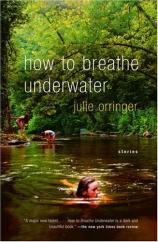Reading Group Guide
Discussion Questions
How to Breathe Underwater

1. "Pilgrims"
* Who are the "pilgrims" of the story, and what makes them pilgrims?
* What might Ella's lost tooth symbolize?
* What keeps the children in the story from telling their parents immediately about Clarie's death?
* How is this story different in tone and feeling from the other stories? How does Orringer use setting, imagery, and other narrative techniques to evoke the savagery of the children?
2. "When She Is Old and I Am Famous"
* Are the talented girls in "Note to Sixth-Grade Self," "When She Is Old and I Am Famous," and "The Isabel Fish" more able to cope with their circumstances than the less obviously accomplished characters in "Care" or "Stars of Motown Shining Bright"?
3. "The Isabel Fish"
* What did Isabel mean to Maddy? What did Isabel mean to Sage?
* Is it grief, jealousy, or something else that makes Sage kill Maddy's fighting fish?
* What role do the parents in this story play in their children's lives? How is their role different from the parents in the other stories?
4. "Note to Sixth-Grade Self"
* What are the mechanics of peer pressure as portrayed in this story? How can parents respond effectively? What makes some young girls better able to cope or revolt than others? Compare the role of peer pressure in this story to the peer pressure in "Stations of the Cross." Does it change when the girls are older, as in "Stars of Motown Shining Bright"?
5. "The Smoothest Way Is Full of Stones"
* What does Rebecca represent to the Orthodox Jewish community that she visits for the summer?
* How is Judaism portrayed in this story? How do religion and morality intersect, and how do they diverge? Orringer has alluded in interviews to being Jewish. How does she celebrate or criticize her Jewish heritage in her stories? [See online interview with Robert Birnbaum, Identitytheory.com and The Morning News, "Birnbaum v. Julie Orringer," October 22, 2003.]
6 "Care"
* What is the meaning of the title of this story? Does the word "care" capture the nature of family love as portrayed in the story --- fraught with obligations, jealousies, and pressure to live up to expectations? Does this title apply to other stories in the collection as well?
* How do Tessa's feelings toward her sister compare to Mira's feelings toward Aïda in "When She Is Old and I Am Famous"?
* How might Tessa survive --- or learn to breathe underwater? Does the story provide any hope for her future?
7. "Stars of Motown Shining Bright"
* What is the narrative effect of giving a character like Lucy a gun? Does Lucy's unfamiliarity with urban violence make the weapon more or less dangerous in her hands? How does the gun change the power dynamic within the story?
* Is the relationship between Lucy and Melissa an accurate portrait of friendship between teenage girls? What is the nature of such a relationship? How does it compare to the relationship between the cousins in "The Smoothest Way Is Full of Stones" or in "When She Is Old and I Am Famous"? How do these relationships between the teenage girls compare to the relationship between brother and sister, as portrayed in "The Isabel Fish"?
8. "What We Save"
* What does Helena save of her mother? What does her mother save of herself? How will Helena's adolescence be even more difficult with the loss of her mother?
* How does Jeremy and Louis's sexual taunting of Helena play into the themes of this story?
9. "Stations of the Cross"
* Why do Carney and Lila behave the way they do toward Dale Fortunot, and how is their behavior similar to or different from the way the children behave toward each other in "Pilgrims"? Is there ever any circumstance in which behavior like that can be justified or understood?
* This is the only story told from the viewpoint of an adult in which she retrospectively judges her behavior as a child. How does this narrative point of view affect the tone of this story and differentiate it from the other stories?
10. For discussion of How to Breathe Underwater
* In an interview in which Orringer spoke of the themes of her story collection, she mentioned "young women entering a point in their lives when they're asked to make what seems like an impossible transition" ["An Interview with Julie Orringer and Vendela Vida" by Dave Weich on Powells.com, September 10, 2003]. What are the "impossible transitions" the young girls of Orringer's stories are being asked to make? What helps Orringer's characters finally "breathe underwater"? Do the girls learn to breathe on their own, or do they rely on the assistance of others?
* A recurring theme in the stories is the difficulty the children have in communicating with the people closest to them. Are these communication breakdowns caused by generation gaps or by other circumstances? Are the children's deepest thoughts and feelings apparent at all to the adults around them? Would better communication make a difference in their lives?
* The ages of the central female characters in the stories range from nine- and ten-year-olds ("Pilgrims" and "Stations of the Cross") all the way to the twenty-year-olds ("When She Is Old and I Am Famous" and "Care"). Do you notice a progression in the stories as the younger characters evolve into older girls? Is there a noticeable point or age at which the girls begin to lose their innocence?
* How does the choice of narrative voice, i.e., first person ("When She Is Old and I Am Famous," "The Isabel Fish," "The Smoothest Way Is Full of Stones," "Stations of the Cross"), second person ("Note to Sixth-Grade Self") or third person ("Pilgrims," "Care," "Stars of Motown Shining Bright," "What We Save"), change the tone of the stories? Does the choice of narrative voice affect the reader's ability to relate to or empathize with the characters?
* How does the mother's illness or death affect each family in "Pilgrims," "What We Save," "The Smoothest Way Is Full of Stones," and "Care"? How do the experiences of the children differ? Do Ella and her brother ("Pilgrims") find different means of coping than Helena and Margot ("What We Save")?
* What images of teenage boys emerge from the stories, in particular Sage in "The Isabel Fish," Dovid Frankel in "The Smoothest Way Is Full of Stones," Jeremy and Louis in "What We Save," Jack Jacob in "Stars of Motown Shining Bright," and Eric Cassio in "Note to Sixth-Grade Self?" How do the male characters give us insight into the actions and personalities of the girls? Why do these males find themselves in conflict with the girls?
* The fathers in the stories are effectively absent (e.g., "Stations of the Cross"), helpless (e.g., "Pilgrims" and "The Smoothest Way Is Full of Stones"), or both (e.g., "What We Save" and "Care"), but they are all typically well meaning (e.g., "The Isabel Fish"). What keeps these fathers from paying closer attention to their daughters, or from being better able to serve their emotional needs?
How to Breathe Underwater
- Publication Date: April 12, 2005
- Paperback: 226 pages
- Publisher: Vintage
- ISBN-10: 1400034361
- ISBN-13: 9781400034369








